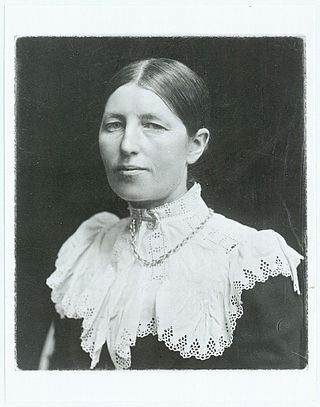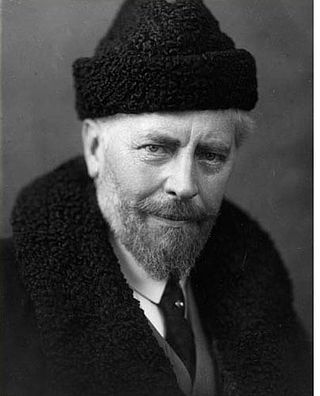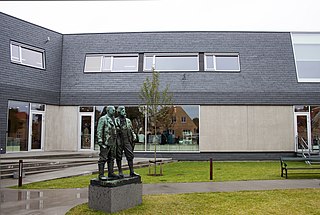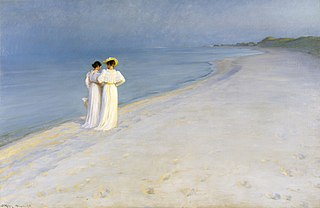
Skagen is the northernmost town in Denmark, on the east coast of the Skagen Odde peninsula in the far north of Jutland, part of Frederikshavn Municipality in Nordjylland, 41 kilometres (25 mi) north of Frederikshavn and 108 kilometres (67 mi) northeast of Aalborg. The Port of Skagen is Denmark's main fishing port and it also has a thriving tourist industry, attracting 2 million people annually.

Peder Severin Krøyer, also known as P. S. Krøyer, was a Danish painter.

Michael Peter Ancher was a Danish realist artist, and widely known for his paintings of fishermen, the Skagerak and the North Sea, and other scenes from the Danish fishing community in Skagen.

Anna Ancher was a Danish artist associated with the Skagen Painters, an artist colony on the northern point of Jylland, Denmark. She is considered to be one of Denmark's greatest visual artists.

Hjalmar Eilif Emanuel Peterssen was a Norwegian painter. He is most commonly associated with his landscapes and portraits. He gained early recognition for the history painting Christian II signing the Death Warrant of Torben Oxe and established himself as one of Norway's foremost portrait painters, with portraits of, among others, Henrik Ibsen and Edvard Grieg. He also became known for his landscape paintings, and became part of the artist circle known as the Skagen Painters. He also became known for his design in 1905 of Norway's national coat of arms with the Norwegian lion, which was used by the government and the royal house. The design is still used in the royal coat of arms and the royal flag.

The Skagen Painters were a group of Scandinavian artists who gathered in the village of Skagen, the northernmost part of Denmark, from the late 1870s until the turn of the century. Skagen was a summer destination whose scenic nature, local milieu and social community attracted northern artists to paint en plein air, emulating the French Impressionists—though members of the Skagen colony were also influenced by Realist movements such as the Barbizon school. They broke away from the rather rigid traditions of the Royal Danish Academy of Fine Arts and the Royal Swedish Academy of Arts, espousing the latest trends that they had learned in Paris. Among the group were Anna and Michael Ancher, Peder Severin Krøyer, Holger Drachmann, Karl Madsen, Laurits Tuxen, Marie Krøyer, Carl Locher, Viggo Johansen and Thorvald Niss from Denmark, Oscar Björck and Johan Krouthén from Sweden, and Christian Krohg and Eilif Peterssen from Norway. The group gathered together regularly at the Brøndums Hotel.

Hip, Hip, Hurrah! is an oil-on-canvas painting from 1888 by Danish painter Peder Severin Krøyer.

Oscar Gustaf Björck was a Swedish painter and a professor at the Royal Swedish Academy of Arts.

Roses is an 1893 painting by P. S. Krøyer, one of the most successful artists of the community known as the Skagen Painters which flourished in Skagen in the north of Jutland in the late 19th century. The work shows Marie Krøyer, the artist's wife, seated in a deckchair under a large rose bush in the garden of a house they rented in Skagen, with their dog Rap asleep beside her.

Skagens Museum is an art museum in Skagen, Denmark, that exhibits an extensive collection of works by members of the colony of Skagen Painters who lived and worked in the area in the late 19th and early 20th centuries. Important artists include Marie and P. S. Krøyer, Anna and Michael Ancher, Laurits Tuxen, Viggo Johansen, and Holger Drachmann. The museum also hosts special exhibitions. Its facilities include a café in the Garden House, an old building which for a while served as home residence and studio of Anna and Michael Ancher.

Anchers Hus is an art museum and gallery situated in the former residence of the painters Michael and Anna Ancher in Skagen, Denmark. Anchers Hus is located on Markvej in Skagen, Denmark.

Brøndums Hotel, in the little harbor town of Skagen in the north of Denmark, is remembered for its close associations with the late 19th-century artists colony known as the Skagen Painters. It still operates as a hotel today.

Fritz Stoltenberg was a German landscape and marine painter. After a summer with the Skagen Painters in 1884, he returned to Kiel where he painted and sketched the old town and the harbor, publishing many of his illustrations in local magazines.

Drachmann's House, also known as Villa Pax, is one of the major houses of Skagen, northern Denmark. Located on Hans Baghs Vej towards the western side of the town, it was built in 1829 and is now a museum. It is a writer's home museum dedicated to the writer and marine painter Holger Drachmann who lived in the house from 1902 until his death in a sanatorium in Hornbæk in January 1908. Drachmann had regularly visited Skagen from 1871.

Midsummer Eve Bonfire on Skagen Beach is a 1906 painting by the Danish artist P.S. Krøyer. The large work, which took several years to complete, shows many of the artists in the group known as the Skagen Painters as well as influential members of Skagen's local community.

Launching the Boat. Skagen is an 1884 painting by the Swedish artist Oscar Björck. It depicts the activities of the local fishermen, a favourite subject for the Skagen Painters. Launching the Boat is the largest of Björck's open-air paintings from Skagen. It is on display in Skagens Museum.

Peder Severin Krøyer painted various portraits of his wife, Marie Krøyer née Triepcke, a fellow Danish artist who was said to be one of the most beautiful women in Copenhagen. Norwegian-born Peder had met and painted Marie in Copenhagen but fell in love with her when they met in Paris in 1889. After a honeymoon in northern Jutland and Italy, the couple settled in Skagen on the northern tip of Jutland in 1891, joining the group of artists that became known as the Skagen Painters.

Summer Evening on Skagen's Southern Beach is a painting by Peder Severin Krøyer (1851–1909), from 1893, and is counted as one of his masterpieces. Krøyer was one of the most notable members of the Danish artistic community known as the Skagen Painters. The works of Krøyer often emphasise the special effects of the Skagen light, with several memorable works depicting beach scenes.

Helga Cathrine Ancher (1883–1964) was a Danish painter. As the daughter of Anna and Michael Ancher, she was closely associated with the Skagen Painters. Most of her paintings were of her family and friends in Skagen and of local landscapes.























